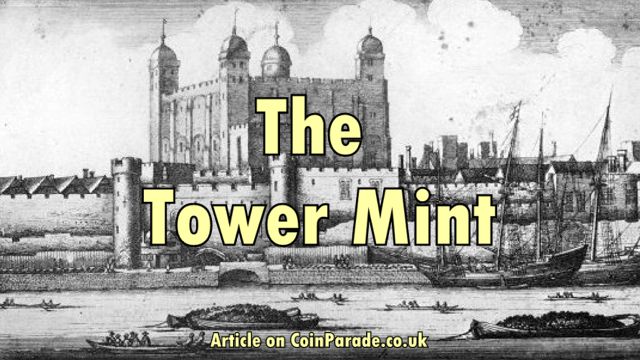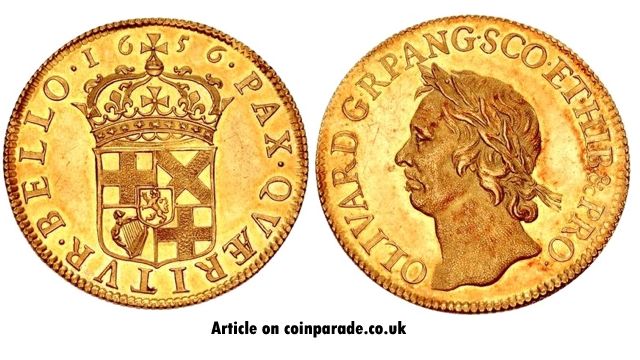
History of The Tower Mint, London 1279-1812
While the Royal Mint can find its origins dating back to 886AD and King Alfred the Great, during the period 1279-1812 it was generally referred to as The Tower Mint as it was housed at the Tower of London.
by Les Kendall
Prior to 1279 coins were minted locally at Provincial Mints by an official Moneyer. A moneyer is a private individual who was officially permitted to mint coins. Moneyers have been around from ancient times, and in the Middle Ages Moneyers were appointed by the King and it was an important and trusted role. Moneyers claimed to have the exclusive right to mint coins, but from now on all important decisions would be made by the King and Master of the Mint.
Early Days
The first buildings were probably located near to the Byward Tower at the west end of Mint Street, but the Mint soon expanded to occupy most of the space between the inner and outer walls of the Tower.
As the Tower Mint had to compete with the provincial mints, coins were minted only as required and many of the employees of the Tower Mint were part-time local agricultural workers who attended on demand. The Mint favoured the long warm summer days to the short dark, cold days of winter as the workers would be more productive and have less accidents. Some years saw no coin production at all.
By the end of the 14th century most of the provincial mints were closed and centralised to the Mint which was housed at the Tower of London. In 1472 a Mint board was established with defined roles like Master of the Mint, Warden of the Mint and Comptroller. Between them their responsibilities ranged from managing the engravers and moneyers, managing quality, finances of the Mint and representing the Monarchy at the Mint.
From the reign of Henry VII (1484-1509) there was more effort put into engraving an actual image of the monarch rather than just a cartoon like effigy.
The Great Debasement
The centralisation of the Royal Mint allowed greater control by the Monarchy, and this sometimes led to easier manipulation of the currency. Henry VIII (1509-1547) drastically overspend with a lavish lifestyle, not helped by England’s continual wars against one country or another.
Even as the rest of Europe flourished, Henry’s answer was to debase the currency, which means reducing the amount of precious metal in the coins. In the The Great Debasement (1544-1551), Gold was reduced from 23 carats to 20 carats and silver coins suffered even more, reducing the content from 92.5% sterling silver to only 25%.
It was left to Elizabeth I in 1551 to reverse the debasement policy and restore the fineness of coins to its former level.
Early Milling Experiments
In the 1550’s coins were still being made by hitting the die with a hammer by hand. This resulted in the metal splashing out and resulting in an irregular shaped coin which would easily be ‘clipped’. Clipping is cutting little pieces of metal off the edge of the coin, and as these were gold and silver coins it was a lucrative practice. Coins lost weight and got worn more quickly.
So an effort was made to use a screw press to make the coins, a process known as milling. This resulted in rounder, thicker coins which were much more difficult to clip.
The Paris Mint had already started the move towards milled coinage so in 1561 Eloy Mestrelle (sometimes spelled Eloye) came from France (in somewhat dubious circumstances) to set up a mill with a screw press. The results were so good that even Queen Elizabeth visited the Mint to view the work.
However, in 1572 the new Warden of the Mint, Richard Martin, and the Company of Moneyers found Mestrelle’s techniques unacceptably slow for production, maybe ten times slower than hammered coinage. The experiment was also expensive to run so was discontinued.
Mestrelle knew how to make quality coins, but unfortunately he had a habit of making a few for his own use, eventually earning him a one-way trip to the gallows in 1578.
In 1625 another Frenchman, Nicholas Briot, came to the Mint to make another attempt; this too failed. Briot was a talented engraver and in 1633 became chief engraver to the Royal Mint.
No Copper Coins
When England and Scotland formed the Union in 1603 the pound sterling and pound Scots began to merge. As there was a big difference in the value of the coins, many unofficial tokens were minted to cover the difference.
The Royal Mint wanted to mint only profitable gold and silver coins and so introduced a licence so that private mints could issue farthings. It was 1672 before the Royal Mint began official production of Copper coins.
The Civil War (1642-1651)
After Charles I entered Parliament and tried to arrest the Five Members, things didn’t go too well for the King and he was forced to flee London. As he had need of money to pay for armies, Charles set up a number of mints around the country. Using any silver he could lay he hands on, the coins were often just hammered out as quickly as possible.
The Roundheads (or Parliamentarians) eventually caught up the these mints and closed them, although others then opened somewhere else in the country. After Charles was caught and executed, the Commonwealth of England introduced its own set of coins which were made at the Tower Mint.
The Engineering of Peter Blondeau
For minting technology, France was still well ahead of England. Hammered coinage was banned in France in 1639 and milled coinage (coins made by machines) were now the standard. Around 1649 the government asked Peter (Pierre) Blondeau who worked at the Paris Mint to come to London and introduce some of the new technology such as milled coins with edge lettering.
This didn’t always go well with other English Moneyers who worked for the Mint and now feared for their jobs. The fear of reprisal was the reason Blondeau moved to Drury House as the Tower Mint couldn’t guarantee the security of his machines. Working with die engraver Thomas Simon, the coins produced were of exceptional quality.
Commonwealth coins were issued between 1649 and 1660. They had no portraits, instead showing the Cross of St George and the Harp of Ireland. The inscriptions were in English rather than Latin. However, coins bearing the head of Oliver Cromwell were also produced and showed the quality of the new milled coinage.

Cromwell was a big fan of Blondeau, but when Cromwell died suddenly in 1658 Blondeau thought it safer to move back to France. The Mint had to briefly return to hammered coins, but it had glimpsed the future of coinage.
The Monarchy was restored in 1660, and in 1662 Charles II asked Peter Blondeau to return and permanently establish milled coinage. To prevent clipping, edge lettering was introduced. The Mint also employed the Roettier brothers, members of the famous engraver family from the Netherlands.
Parliament took over control of the mint from the Crown in 1688, following the Glorious Revolution and the deposing of James II.
Isaac Newton becomes the new Master
Sir Isaac Newton, probably the World’s most famous scientist, became Warden of the Mint in 1696 and then Master of the Mint from 1699. The title was maybe intended to be honorary, but Newton took full charge. Initially his goal was to improve the quality of English coinage and also to reduce the amount of counterfeits in circulation which was maybe as high as 10%.
The Great Recoinage of 1696, by the Coin Act 1696 under William III, forced all coins in circulation to be removed and replaced by new coinage. This was a large demand, so some temporary satellite mints in Bristol, Chester, Exeter, Norwich, and York were created to help in the production. These mints used mint marks as well as marks to show where the metal came from, for example roses for West England and Plumes for Welsh silver.
Due to clipping and counterfeiting, coins were exchanged by weight, not by face value. The 1696 Act also made counterfeiting an act of high treason. Newton chased after counterfeiters with a vengeance, and his epic battle with serial counterfeiter and confident trickster William Chaloner is told in the book Newton and the Counterfeiter.
By 1717 Newton had a bigger problem as the bimetallic standard of gold and silver collided between Europe and the far East, leaving the mint with virtually no silver supplies. Newton wrote a report to the Lords Commissioners of His Majesty’s Treasury highlighting how in Britain an ounce of gold could buy almost fifteen and a half ounces of silver but in East India you could buy an ounce of gold for twelve ounces of silver. So anyone who could afford it took silver to India to buy gold and then exchanged the gold for silver in Britain.
Newton asked, and the King agreed, that the Guinea (the main gold coin of the day) should be devalued. The reply on the 22 December 1717 was a Royal Proclamation “forbidding the exchange of gold guineas for more than 21 silver shillings“. Whether it was intended or not, Great Britain was moving toward the Gold Standard. For more discussion, see our article The Quarter-Guinea and Other Problems.
Life at the Mint
Working at the Mint was not just a job, it was an entire way of life. From the 16th century many of the employees and their families lived within the Tower walls on Mint Street. They worshipped at the chapel of St Peter ad Vincula on Tower Green. The employee’s sons became apprentices when young. Some lived their entire life there and some (like engraver Lewis Pingo) were buried there.
Visiting experts, such as the Roettiers family, would be offered lodging in Mint Street. The cramped and noisy street was not to everyone’s taste: Isaac Newton sub-let his room to a junior mint employee and preferred to live in Chelsea.
The Industrial Revolution
From around 1760, Britain saw a huge increase in steam power, machine tools and factories. There was an unprecedented rise in population and a massive demand for coinage to pay wages to the new factory workers. Some companies took to minting their own tokens to fill the demand for small coins. It was clear that a major process improvement was going to be needed at the Mint.
Up in Birmingham, Matthew Boulton and James Watt were successfully minting copper pennies and twopences under licence from the Royal Mint. The 1797 Cartwheel Penny was the first coin to be made by a steam powered machine.
Boulton’s machines were going to be the new future of minting. The problem was that the Tower hadn’t got enough room to house these steam monsters and the Royal Mint needed a new home. They didn’t have to look far and a new building was started at Tower Hill, just over the road from the existing Tower Mint.
The new building completed in 1809 and in 1812 the formal ceremony of returning the keys to the Constable of the Tower was carried out for the last time. The era of the Tower Mint was at an end.












